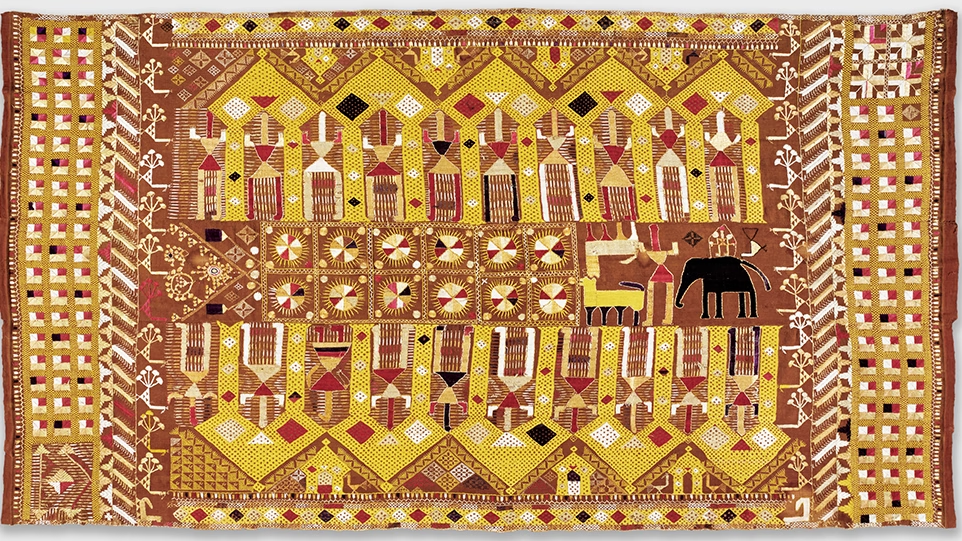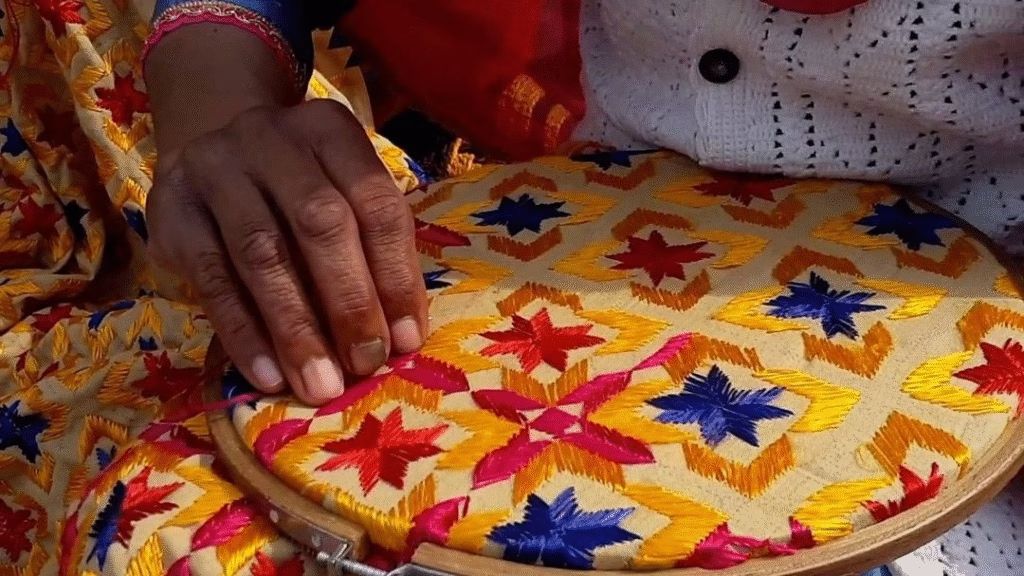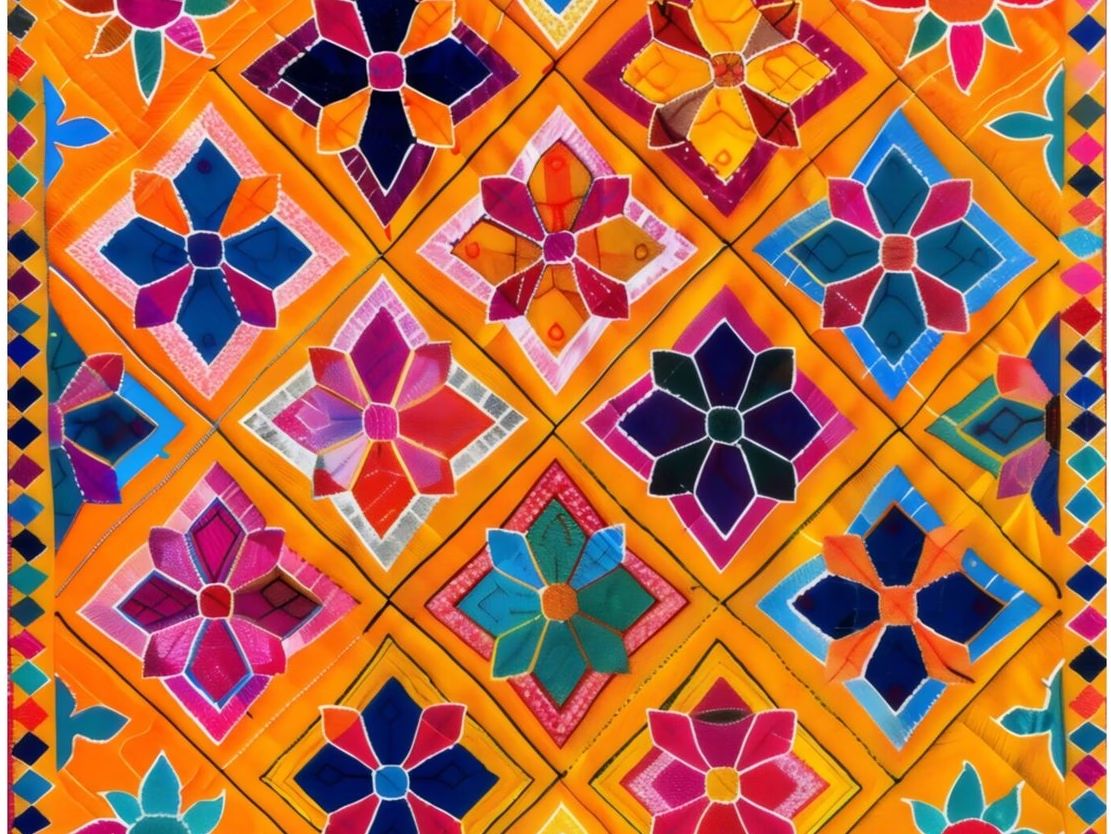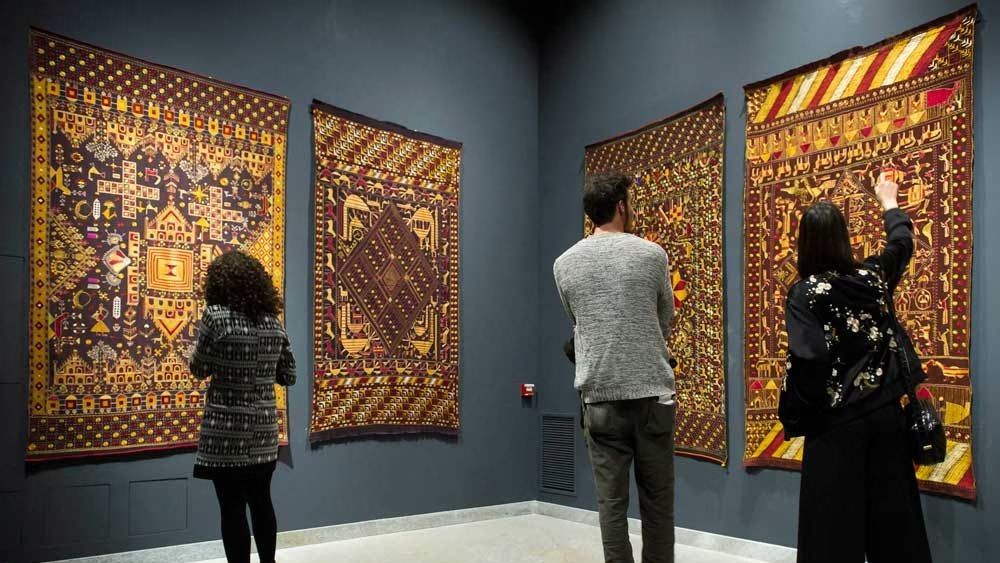Hello dear readers! 🌸 Today, let’s take a joyful trip to the heart of Punjab, where every stitch tells a story- the story of Phulkari, the art that literally means “flower work.” Bursting with color, warmth, and tradition, Phulkari isn’t just embroidery; it’s an expression of love, patience, and pride.
For centuries, Punjabi women have used their needles and vibrant silk threads to weave dreams onto plain fabrics, turning them into glowing pieces of art.
Traditionally, these hand-embroidered masterpieces were made for weddings, festivals, and special family moments , each one carrying blessings and emotions in every stitch. From the golden fields of Punjab to global fashion ramps today, Phulkari has traveled far yet stayed close to its roots.
🏵️ Historical Threads: The Origin of Phulkari Art
The story of Phulkari Art, meaning “flower work”, blooms from the heart of Punjab’s rural life, where every stitch carried emotion, pride, and heritage. Its roots go back to the 15th century, with references found in old Punjabi folklore and even in the verses of Guru Nanak Dev Ji. Back then, Phulkari wasn’t just embroidery, it was a heartfelt expression of a woman’s dreams, woven lovingly onto coarse cotton fabric called khaddar using bright silk threads known as pat.
Traditionally, mothers, daughters, and grandmothers would sit together, crafting Phulkari Art for weddings, childbirths, and festive occasions. Each design told a story—of joy, faith, and family bonds. The most famous types, like Bagh Phulkari (where the fabric is completely covered with embroidery) and Chope (gifted to brides), reflected love and blessings in their vivid patterns.
Interestingly, this art was never meant for sale; it was a labor of love, passed down through generations as family heirlooms. Over time, Phulkari Art grew from a household tradition into a symbol of Punjab’s cultural identity, admired across India and beyond. Each stitch still whispers the same story—of a woman’s patience, devotion, and the timeless beauty of Punjab’s golden heritage.
🌸 The Essence of Phulkari: More Than Just Embroidery

Phulkari Art is not just an art form — it’s an emotional language stitched in color, a reflection of Punjab’s vibrant spirit and the soulful hands that create it.
- A Symbol of Love and Identity
- Each Phulkari piece is handmade by women, often as a gift for daughters or brides.
- It carries emotions, blessings, and family pride — turning a fabric into a memory.
- Each Phulkari piece is handmade by women, often as a gift for daughters or brides.
- A Dance of Colors and Patterns
- Bright threads of gold, crimson, orange, and pink blend together like a Punjabi celebration.
- The geometric symmetry and floral patterns represent life’s rhythm — bold, cheerful, and full of warmth.
- Bright threads of gold, crimson, orange, and pink blend together like a Punjabi celebration.
- More Than Decoration
- Traditionally, women stitched Phulkari during happy moments — it was their silent storytelling.
- Every stitch spoke of patience, dreams, and devotion.
- Traditionally, women stitched Phulkari during happy moments — it was their silent storytelling.
- A Cultural Signature
- Worn during weddings, festivals, and family gatherings, Phulkari symbolizes prosperity and grace.
- Worn during weddings, festivals, and family gatherings, Phulkari symbolizes prosperity and grace.
🎨 Materials Used and Steps of Making

Each Phulkari Art is a handmade masterpiece, created with simple tools but endless devotion. Let’s explore what materials bring this art to life and how every Phulkari takes shape, one thread at a time.
🧵 1. Materials Used in Phulkari Art
Before the needle begins its dance on fabric, a few essential materials set the stage for magic.
🌾 a. Base Fabric (Khaddar or Handspun Cloth)
- Traditionally, Phulkari Art is embroidered on Khaddar, a thick, handspun cotton fabric.
- It’s usually dyed in earthy tones like brown, maroon, black, or indigo to make the bright threads shine vividly.
- Khaddar is chosen for its strength and texture, which hold the stitches firmly for years.
- Today, modern versions may use cotton, silk, or georgette, but traditionalists still prefer pure Khaddar.
🌈 b. Thread (Pat – Silk Floss Thread)
- The soul of Phulkari Art lies in its thread, locally called Pat.
- Made from untwisted silk, it gives a lustrous finish that glows beautifully against dark fabrics.
- Earlier, threads were dyed naturally using flowers and leaves, giving shades of red, yellow, green, orange, and pink.
- Each color has a symbolic meaning — red for love, yellow for happiness, and white for purity.
🪡 c. Needle (Sui)
- A fine, long needle is used to make precise stitches.
- The artisans never mark the design; instead, they rely on memory and imagination, making each piece truly unique.
🧺 d. Frame and Other Tools
- Some weavers use an embroidery frame to keep the fabric tight and smooth.
- Scissors, chalk, and wooden stands are used occasionally to assist with larger designs.
✋ 2. Steps of Making Phulkari Art
Now that we have the materials ready, let’s walk through the beautiful process of creating this art — step by step.
🌼 Step 1: Preparing the Fabric
- The Khaddar fabric is washed, dried, and dyed to achieve a rich background color.
- It’s then cut to the desired size, depending on whether it will become a dupatta, shawl, or cloth piece.
- The cloth is stretched tightly to ensure smooth stitching.
🧶 Step 2: Choosing the Pattern and Colors
- Unlike modern printed designs, traditional Phulkari relies purely on mental visualization.
- The weaver decides the motif placement, color combination, and layout before starting.
- Patterns are often inspired by flowers, peacocks, diamonds, mirrors, or geometrical shapes — each carrying a symbolic story.
🪡 Step 3: Starting the Embroidery
- The most common stitch used is the darning stitch — a simple back-and-forth thread movement that creates dazzling motifs.
- The embroidery is done from the reverse side of the fabric, while the beauty appears on the front.
- Every thread is laid carefully to reflect light and give a shimmering effect, especially under sunlight.
🌸 Step 4: Building the Design
- The artisan begins from the center and works outward.
- Larger motifs are created first, followed by smaller ones to fill empty spaces.
- Colors are layered beautifully, forming floral or geometric patterns that look almost three-dimensional.
💫 Step 5: Finishing Touches
- Once the embroidery is complete, the Phulkari Art is gently washed and ironed to make the silk threads glow.
- Borders may be added using contrasting stitches to frame the design elegantly.
- The final piece is a vivid tapestry of emotion, ready to be worn or gifted on joyous occasions.
🌺 3. The Beauty Behind Every Stitch
- A single Phulkari Art can take weeks or even months to complete, depending on its complexity.
- Women often work together, singing folk songs as they stitch — turning the process into a celebration of creativity and togetherness.
- What’s fascinating is that no two Phulkaris are ever identical; each carries the personal touch and emotion of its creator.
🌸 Symbols and Motifs: Meaning Woven in Every Thread

When we look at a piece of Phulkari embroidery, we’re not just seeing patterns or colors — we’re witnessing emotions, stories, and memories carefully stitched by hand. Every thread in Phulkari carries a message, every motif holds a secret, and every design whispers a part of Punjab’s living heritage. Let’s walk through the world of these symbolic motifs that make Phulkari a timeless masterpiece.
1️⃣ Floral Motifs – The Bloom of Emotions
- Flowers are the heart of Phulkari designs.
- Each flower — from blooming lotuses to delicate marigolds — represents beauty, purity, and joy.
- The vibrant floral motifs express a woman’s happiness, her love for nature, and her festive spirit.
- In bridal Phulkaris, flowers symbolize prosperity and new beginnings, making them a must in wedding trousseaus.
- Large flower patterns are often surrounded by tiny buds, showing the continuity of life and family bonds.
2️⃣ Geometric Motifs – Balance and Perfection
- Squares, diamonds, triangles, and grids are more than just designs — they reflect order and discipline in creativity.
- The diamond pattern (called “Chowkdi”) is one of the most famous motifs, representing the four directions and balance in life.
- These shapes are embroidered with mathematical precision, showing the artisan’s focus and patience.
- The symmetry of geometric motifs mirrors the balance between hard work and harmony in Punjabi households.
3️⃣ Peacock Motifs – Beauty and Pride
- The peacock, the national bird of India, often graces Phulkari designs as a symbol of grace, beauty, and pride.
- In Punjab, the peacock also represents love and monsoon joy, reminding people of rainy days and dancing peacocks in fields.
- A bride’s Phulkari Art often includes peacocks to express hope, elegance, and the colorful journey ahead in her married life.
4️⃣ Animal and Bird Motifs – Nature’s Companions
- Apart from peacocks, artisans also weave sparrows, parrots, elephants, and camels.
- These motifs tell stories of daily rural life, where animals play vital roles in farming, companionship, and festivities.
- The parrot, for example, symbolizes communication and love messages, as it often appears in Punjabi folklore.
- Elephants and camels symbolize strength and endurance, reflecting the hardworking spirit of Punjab.
5️⃣ Mirror Motifs – Reflections of the Soul
- Tiny mirrors are sometimes added to Phulkari Art work to make it sparkle and come alive.
- Mirrors represent truth, light, and self-awareness.
- They are often stitched in circular or diamond frames to ward off evil eyes and attract positivity.
- The glimmer of mirror work catches the light beautifully, turning the cloth into a living artwork.
6️⃣ Sun and Star Motifs – Symbols of Hope
- Circular sun motifs stand for energy, warmth, and optimism — qualities deeply rooted in Punjabi life.
- Star-shaped patterns are believed to bring luck and blessings.
- These celestial designs add depth to the embroidery, showing how even the sky becomes a part of Phulkari’s imagination.
7️⃣ Bawan Bagh Motif – The Garden of Fifty-Two Designs
- The most intricate and legendary design in Phulkari is the Bawan Bagh, meaning “garden of fifty-two patterns.”
- It includes multiple motifs — flowers, birds, stars, and geometrical shapes — all stitched together in perfect harmony.
- This masterpiece symbolizes abundance, creativity, and a woman’s artistic expression without boundaries.
8️⃣ Phulkari Borders – Threads that Frame Stories
- The borders, called “Phulkari Da Kinara”, are not just frames but finishing touches that bind every story together.
- Borders often feature zigzag or vine patterns, representing continuity, connection, and the never-ending cycle of life.
- They act as a boundary yet hold every emotion within — much like traditions in a family.
Present Scenario and Statistics

- Empowerment of Women Artisans
- In the district of Bathinda, over 150 under-privileged women have been trained in Phulkari embroidery, giving them new income opportunities and social respect.
- A dedicated initiative trained 300 women from 22 villages in Punjab for Phulkari craft and commercial skills in 2023–24, reflecting how the art form is reshaping lives.
- In the district of Bathinda, over 150 under-privileged women have been trained in Phulkari embroidery, giving them new income opportunities and social respect.
- Digital and Market Innovations
- The Government of Punjab launched an official web portal in November 2024 to showcase, sell and track Phulkari items, linking artisans directly to buyers online.
- The state’s handicraft body onboarded Phulkari-brand products onto major e-commerce platforms like Flipkart through the “Samarth” initiative, unlocking wider digital markets.
- The Government of Punjab launched an official web portal in November 2024 to showcase, sell and track Phulkari items, linking artisans directly to buyers online.
- Export and International Reach
- Phulkari Art recently featured on global platforms—Punjab artisans showcased their pieces at a major sourcing fair in Dubai, marking a step into international trade.
- Though largely informal, reports suggest the craft supports over 200,000 women in Punjab, underpinning its socio-economic significance.
- Phulkari Art recently featured on global platforms—Punjab artisans showcased their pieces at a major sourcing fair in Dubai, marking a step into international trade.
- Challenges & Craft Authenticity
- One study estimates that the number of practising genuine Phulkari artisans has dropped to fewer than 5,000, due to competition from machine-made imitations.
- Efforts are underway to preserve authentic hand-work—training, design documentation and cluster development are playing key roles.
- One study estimates that the number of practising genuine Phulkari artisans has dropped to fewer than 5,000, due to competition from machine-made imitations.
- Cluster Presence & Regional Development
- The Punjab Government’s handicraft cluster list shows specific zones (e.g., Rajpura, Abohar, Mansa) designated for Phulkari development, signalling focused regional growth.
- In the city of Patiala, more than 300 retail and wholesale shops sell Phulkari-embroidered fabrics and products, maintaining a local commercial hub
- The Punjab Government’s handicraft cluster list shows specific zones (e.g., Rajpura, Abohar, Mansa) designated for Phulkari development, signalling focused regional growth.
Conclusion:
Phulkari Art is not just embroidery—it’s the heartbeat of Punjab woven in color, patience, and love. Each stitch carries the warmth of tradition and the pride of generations of women who turned simple threads into living poetry.
Today, as this timeless art finds its place in global fashion and modern homes, it continues to tell stories of joy, resilience, and identity. Phulkari Art reminds us that true beauty lies in our roots—crafted by hands, nurtured by culture, and carried forward with grace. In every vibrant thread, Punjab’s soul still dances, radiant and alive.
Read also: Phad Painting in Fashion: Rajasthan’s Story Scrolls on Jackets and Bags


Leave a Reply